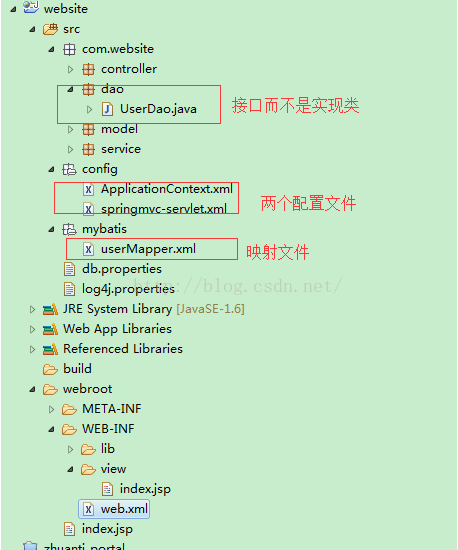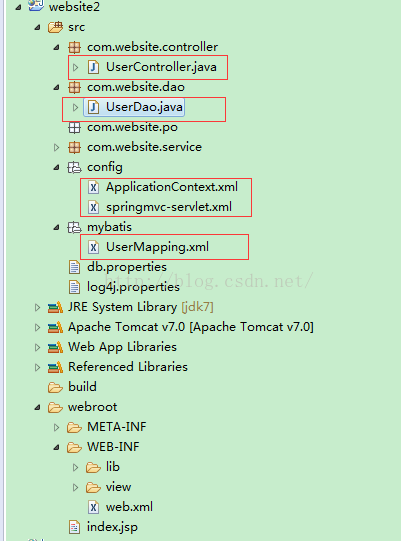spring、mybatis 配置方式详解(常用两种方式)
在之前的文章中总结了三种方式,但是有两种是注解sql的,这种方式比较混乱所以大家不怎么使用,下面总结一下常用的两种总结方式:
一、 动态代理实现 不用写dao的实现类
这种方式比较简单,不用实现dao层,只需要定义接口就可以了,这里只是为了记录配置文件所以程序写的很简单:
1、整体结构图:

2、三个配置文件以及一个映射文件
(1)、程序入口以及前端控制器配置 web.xml
<?xml version="1.0" encoding="UTF-8"?> <web-app xmlns:xsi="http://www.w3.org/2001/XMLSchema-instance" xmlns="http://java.sun.com/xml/ns/javaee" xsi:schemaLocation="http://java.sun.com/xml/ns/javaee http://java.sun.com/xml/ns/javaee/web-app_3_0.xsd" id="WebApp_ID" version="3.0"> <display-name>website1</display-name> <!-- 设置监听,在web容器启动时自动装配ApplicationContext的配置信息--> <listener> <listener-class>org.springframework.web.context.ContextLoaderListener</listener-class> </listener> <!-- 设置Spring容器加载配置文件路径 --> <context-param> <param-name>contextConfigLocation</param-name> <param-value> classpath:config/springmvc-servlet.xml, classpath:config/ApplicationContext.xml </param-value> </context-param> <!-- 字符编码过滤器 --> <filter> <filter-name>encodingFilter</filter-name> <filter-class>org.springframework.web.filter.CharacterEncodingFilter</filter-class> <init-param> <param-name>encoding</param-name> <param-value>utf-8</param-value> </init-param> <init-param> <param-name>forceEncoding</param-name> <param-value>true</param-value> </init-param> </filter> <filter-mapping> <filter-name>encodingFilter</filter-name> <url-pattern>*.do</url-pattern> </filter-mapping> <!-- 前端控制器 --> <servlet> <servlet-name>springmvc</servlet-name> <servlet-class>org.springframework.web.servlet.DispatcherServlet</servlet-class> <init-param> <param-name>contextConfigLocation</param-name> <param-value>classpath:config/springmvc-servlet.xml</param-value> </init-param> <!-- 这个配置文件在容器启动的时候 就加载 --> <load-on-startup>1</load-on-startup> </servlet> <servlet-mapping> <servlet-name>springmvc</servlet-name> <!-- 拦截请求 --> <url-pattern>*.do</url-pattern> </servlet-mapping> <welcome-file-list> <welcome-file>index.html</welcome-file> <welcome-file>index.htm</welcome-file> <welcome-file>index.jsp</welcome-file> <welcome-file>default.html</welcome-file> <welcome-file>default.htm</welcome-file> <welcome-file>default.jsp</welcome-file> </welcome-file-list> </web-app>
(2)、扫描控制层、自动注入以及视图解析器的配置 springmvc-servlet.xml
<?xml version="1.0" encoding="UTF-8"?> <beans xmlns="http://www.springframework.org/schema/beans" xmlns:xsi="http://www.w3.org/2001/XMLSchema-instance" xmlns:aop="http://www.springframework.org/schema/aop" xmlns:context="http://www.springframework.org/schema/context" xmlns:mvc="http://www.springframework.org/schema/mvc" xmlns:util="http://www.springframework.org/schema/util" xmlns:tx="http://www.springframework.org/schema/tx" xmlns:jdbc="http://www.springframework.org/schema/jdbc" xmlns:cache="http://www.springframework.org/schema/cache" xsi:schemaLocation=" http://www.springframework.org/schema/beans http://www.springframework.org/schema/beans/spring-beans-3.1.xsd http://www.springframework.org/schema/aop http://www.springframework.org/schema/aop/spring-aop-3.1.xsd http://www.springframework.org/schema/context http://www.springframework.org/schema/context/spring-context-3.1.xsd http://www.springframework.org/schema/mvc http://www.springframework.org/schema/mvc/spring-mvc-3.1.xsd http://www.springframework.org/schema/util http://www.springframework.org/schema/util/spring-util-3.1.xsd http://www.springframework.org/schema/tx http://www.springframework.org/schema/tx/spring-tx-3.1.xsd http://www.springframework.org/schema/jdbc http://www.springframework.org/schema/jdbc/spring-jdbc-3.1.xsd http://www.springframework.org/schema/cache http://www.springframework.org/schema/cache/spring-cache-3.1.xsd"> <!-- 注解驱动 --> <mvc:annotation-driven /> <!-- <context:annotation-config /> --> <!-- context:component-scan 具有annotation-config 的功能 --> <!-- 扫描 控制层 --> <context:component-scan base-package="com.website.controller"></context:component-scan> <!-- 视图解析器 --> <bean id="viewResolver" class="org.springframework.web.servlet.view.InternalResourceViewResolver"> <property name="prefix" value="/WEB-INF/view/"> </property> <property name="suffix" value=".jsp"></property> </bean> </beans>
(3)、数据源、service 自动扫描注入、spring代管mybatissqlsessionFactory 、dao层接口动态代理以及事务的配置ApplicationContext.xml
这里会有多中配置文件
1)、单数据源,动态代理实现dao层接口时不设置sqlSessionFactoryBeanName、或sqlSessionTemplateBeanName 两个属性的值
<?xml version="1.0" encoding="UTF-8"?>
<beans xmlns="http://www.springframework.org/schema/beans" xmlns:xsi="http://www.w3.org/2001/XMLSchema-instance"
xmlns:tx="http://www.springframework.org/schema/tx" xmlns:context="http://www.springframework.org/schema/context"
xsi:schemaLocation="http://www.springframework.org/schema/beans http://www.springframework.org/schema/beans/spring-beans-3.2.xsd
http://www.springframework.org/schema/context
http://www.springframework.org/schema/context/spring-context-3.2.xsd
http://www.springframework.org/schema/tx
http://www.springframework.org/schema/tx/spring-tx-3.2.xsd">
<!-- 加载配置JDBC文件 -->
<context:property-placeholder location="classpath:db.properties" />
<!-- 数据源 -->
<bean id="dataSource" class="org.springframework.jdbc.datasource.DriverManagerDataSource">
<property name="driverClassName">
<value>${jdbc.driverClassName}</value>
</property>
<property name="url">
<value>${jdbc.url}</value>
</property>
<property name="username">
<value>${jdbc.username}</value>
</property>
<property name="password">
<value>${jdbc.password}</value>
</property>
</bean>
<!-- 开启注解配置 即Autowried -->
<!-- <context:annotation-config/> -->
<!--其实component-scan 就有了annotation-config的功能即把需要的类注册到了spring容器中 -->
<context:component-scan base-package="com.website.service" />
<!-- 在使用mybatis时 spring使用sqlsessionFactoryBean 来管理mybatis的sqlsessionFactory -->
<bean id="sqlSessionFactory" class="org.mybatis.spring.SqlSessionFactoryBean">
<property name="dataSource" ref="dataSource" />
<!-- mybatis配置文件路径 -->
<property name="configLocation" value="" />
<!-- 实体类映射文件路径,这里只有一个就写死了,多个可以使用mybatis/*.xml来替代 -->
<property name="mapperLocations" value="classpath:mybatis/userMapper.xml" />
</bean>
<!-- <bean id="sqlSession" class="org.mybatis.spring.SqlSessionTemplate"> <constructor-arg index="0"> <ref bean="sqlSessionFactory"/>
</constructor-arg> </bean> -->
<!--动态代理实现 不用写dao的实现 -->
<bean id="MapperScannerConfigurer" class="org.mybatis.spring.mapper.MapperScannerConfigurer">
<!-- 这里的basePackage 指定了dao层接口路劲,这里的dao接口不用自己实现 -->
<property name="basePackage" value="com.website.dao" />
<!-- 如果只有一个数据源的话可以不用指定,但是如果有多个数据源的话必须要指定 -->
<!-- <property name="sqlSessionFactoryBeanName" value="sqlSessionFactory" /> -->
<!--直接指定了sqlsessionTemplate名称,这个和上面的其实是一样的 -->
<!-- <property name="sqlSessionTemplateBeanName" value="sqlSession" /> -->
</bean>
<!--事务管理器 -->
<bean id="transactionManager" class="org.springframework.jdbc.datasource.DataSourceTransactionManager">
<property name="dataSource" ref="dataSource" />
</bean>
<!-- 使用全注释事务 -->
<tx:annotation-driven transaction-manager="transactionManager" />
</beans>
2)、单数据源配置 sqlSessionFactoryBeanName 这个属性值
<?xml version="1.0" encoding="UTF-8"?>
<beans xmlns="http://www.springframework.org/schema/beans" xmlns:xsi="http://www.w3.org/2001/XMLSchema-instance"
xmlns:tx="http://www.springframework.org/schema/tx" xmlns:context="http://www.springframework.org/schema/context"
xsi:schemaLocation="http://www.springframework.org/schema/beans http://www.springframework.org/schema/beans/spring-beans-3.2.xsd
http://www.springframework.org/schema/context
http://www.springframework.org/schema/context/spring-context-3.2.xsd
http://www.springframework.org/schema/tx
http://www.springframework.org/schema/tx/spring-tx-3.2.xsd">
<!-- 加载配置JDBC文件 -->
<context:property-placeholder location="classpath:db.properties" />
<!-- 数据源 -->
<bean id="dataSource" class="org.springframework.jdbc.datasource.DriverManagerDataSource">
<property name="driverClassName">
<value>${jdbc.driverClassName}</value>
</property>
<property name="url">
<value>${jdbc.url}</value>
</property>
<property name="username">
<value>${jdbc.username}</value>
</property>
<property name="password">
<value>${jdbc.password}</value>
</property>
</bean>
<!-- 开启注解配置 即Autowried -->
<!-- <context:annotation-config/> -->
<!--其实component-scan 就有了annotation-config的功能即把需要的类注册到了spring容器中 -->
<context:component-scan base-package="com.website.service" />
<!-- 在使用mybatis时 spring使用sqlsessionFactoryBean 来管理mybatis的sqlsessionFactory -->
<bean id="sqlSessionFactory" class="org.mybatis.spring.SqlSessionFactoryBean">
<property name="dataSource" ref="dataSource" />
<!-- mybatis配置文件路径 -->
<property name="configLocation" value="" />
<!-- 实体类映射文件路径,这里只有一个就写死了,多个可以使用mybatis/*.xml来替代 -->
<property name="mapperLocations" value="classpath:mybatis/userMapper.xml" />
</bean>
<!-- <bean id="sqlSession" class="org.mybatis.spring.SqlSessionTemplate"> <constructor-arg index="0"> <ref bean="sqlSessionFactory"/>
</constructor-arg> </bean> -->
<!--动态代理实现 不用写dao的实现 -->
<bean id="MapperScannerConfigurer" class="org.mybatis.spring.mapper.MapperScannerConfigurer">
<!-- 这里的basePackage 指定了dao层接口路劲,这里的dao接口不用自己实现 -->
<property name="basePackage" value="com.website.dao" />
<!-- 如果只有一个数据源的话可以不用指定,但是如果有多个数据源的话必须要指定 -->
<property name="sqlSessionFactoryBeanName" value="sqlSessionFactory" />
<!--直接制定了sqlsessionTemplate名称,这个和上面的其实是一样的 -->
<!-- <property name="sqlSessionTemplateBeanName" value="sqlSession" /> -->
</bean>
<!--事务管理器 -->
<bean id="transactionManager" class="org.springframework.jdbc.datasource.DataSourceTransactionManager">
<property name="dataSource" ref="dataSource" />
</bean>
<!-- 使用全注释事务 -->
<tx:annotation-driven transaction-manager="transactionManager" />
</beans>
3)、单数据源配置sqlSessionTemplateBeanName 这个属性值
<?xml version="1.0" encoding="UTF-8"?>
<beans xmlns="http://www.springframework.org/schema/beans" xmlns:xsi="http://www.w3.org/2001/XMLSchema-instance"
xmlns:tx="http://www.springframework.org/schema/tx" xmlns:context="http://www.springframework.org/schema/context"
xsi:schemaLocation="http://www.springframework.org/schema/beans http://www.springframework.org/schema/beans/spring-beans-3.2.xsd
http://www.springframework.org/schema/context
http://www.springframework.org/schema/context/spring-context-3.2.xsd
http://www.springframework.org/schema/tx
http://www.springframework.org/schema/tx/spring-tx-3.2.xsd">
<!-- 加载配置JDBC文件 -->
<context:property-placeholder location="classpath:db.properties" />
<!-- 数据源 -->
<bean id="dataSource" class="org.springframework.jdbc.datasource.DriverManagerDataSource">
<property name="driverClassName">
<value>${jdbc.driverClassName}</value>
</property>
<property name="url">
<value>${jdbc.url}</value>
</property>
<property name="username">
<value>${jdbc.username}</value>
</property>
<property name="password">
<value>${jdbc.password}</value>
</property>
</bean>
<!-- 开启注解配置 即Autowried -->
<!-- <context:annotation-config/> -->
<!--其实component-scan 就有了annotation-config的功能即把需要的类注册到了spring容器中 -->
<context:component-scan base-package="com.website.service" />
<!-- 在使用mybatis时 spring使用sqlsessionFactoryBean 来管理mybatis的sqlsessionFactory -->
<bean id="sqlSessionFactory" class="org.mybatis.spring.SqlSessionFactoryBean">
<property name="dataSource" ref="dataSource" />
<!-- mybatis配置文件路径 -->
<property name="configLocation" value="" />
<!-- 实体类映射文件路径,这里只有一个就写死了,多个可以使用mybatis/*.xml来替代 -->
<property name="mapperLocations" value="classpath:mybatis/userMapper.xml" />
</bean>
<bean id="sqlSession" class="org.mybatis.spring.SqlSessionTemplate">
<constructor-arg index="0">
<ref bean="sqlSessionFactory" />
</constructor-arg>
</bean>
<!--动态代理实现 不用写dao的实现 -->
<bean id="MapperScannerConfigurer" class="org.mybatis.spring.mapper.MapperScannerConfigurer">
<!-- 这里的basePackage 指定了dao层接口路劲,这里的dao接口不用自己实现 -->
<property name="basePackage" value="com.website.dao" />
<!-- 如果只有一个数据源的话可以不用指定,但是如果有多个数据源的话必须要指定 -->
<!-- <property name="sqlSessionFactoryBeanName" value="sqlSessionFactory" /> -->
<!--直接制定了sqlsessionTemplate名称,这个和上面的其实是一样的 -->
<property name="sqlSessionTemplateBeanName" value="sqlSession" />
</bean>
<!--事务管理器 -->
<bean id="transactionManager" class="org.springframework.jdbc.datasource.DataSourceTransactionManager">
<property name="dataSource" ref="dataSource" />
</bean>
<!-- 使用全注释事务 -->
<tx:annotation-driven transaction-manager="transactionManager" />
</beans>
4)、多数据源
注意如果是多数据源则一定要使用sqlSessionFactoryBeanName 或sqlSessionTemplateBeanName 来指定具体的数据源,不知道在上面的配置中有没有注意到,如果使用sqlSessionTemplateBeanName 的话要
<bean id="sqlSession" class="org.mybatis.spring.SqlSessionTemplate"> <constructor-arg index="0"> <ref bean="sqlSessionFactory" /> </constructor-arg> </bean>
来创建具体的实例并赋值给sqlSessionTemplateBeanName 这个属性。
(4)、mybatis SQL映射文件 userMapper.xml:
<?xml version="1.0" encoding="UTF-8" ?>
<!DOCTYPE mapper PUBLIC "-//mybatis.org//DTD Mapper 3.0//EN"
"http://mybatis.org/dtd/mybatis-3-mapper.dtd">
<!-- namespace的值就是dao接口的完整路劲,就这个demo而言namespace 就是userDao.java的完整路劲 -->
<mapper namespace="com.website.dao.UserDao">
<!-- 这里的id就是接口中方法的名称 -->
<insert id="saveUser" parameterType="java.util.Map">
insert into user(id,name) values(#{id},#{name})
</insert>
</mapper>
ok 到这里配置文件到搞定了下面来看看控制层,业务逻辑层以及dao层的代码。
3、controller层
package com.website.controller;
import java.util.HashMap;
import java.util.Map;
import javax.servlet.http.HttpServletRequest;
import javax.servlet.http.HttpServletResponse;
import org.springframework.beans.factory.annotation.Autowired;
import org.springframework.stereotype.Controller;
import org.springframework.web.bind.annotation.RequestMapping;
import org.springframework.web.bind.annotation.RequestMethod;
import com.website.service.UserService;
@Controller
@RequestMapping(value = "/user")
public class UserController {
// 注入userService 对象
@Autowired
private UserService userService;
@RequestMapping(value = "/save.do", method = RequestMethod.GET)
public String saveUser(HttpServletRequest request,
HttpServletResponse response) {
String id = request.getParameter("id");
String name = request.getParameter("name");
Map<String, String> map = new HashMap<String, String>();
map.put("id", id);
map.put("name", name);
userService.saveUser(map);
return "index";
}
}
4、service层
package com.website.service;
import java.util.Map;
import org.springframework.beans.factory.annotation.Autowired;
import org.springframework.stereotype.Service;
import org.springframework.transaction.annotation.Transactional;
import com.website.dao.UserDao;
@Service("userService")
@Transactional
public class UserService {
// 注入dao接口实现类实例
// @Resource、@Autowired两种注入方式都可以
@Autowired
private UserDao userDao;
public void saveUser(Map<String, String> map) {
int end = userDao.saveUser(map);
System.out.println("end:" + end);
}
}
5、dao 层 接口
package com.website.dao;
import java.util.Map;
//com.website.dao.UserDao
public interface UserDao {
int saveUser(Map<String, String> map);
}
dao 接口的完整路劲就是这个dao 接口对应的那个映射文件的namespace 而方法名就是 id的值
ok到这里这种配置方式都完了,也有了一个完整的小demo,下面我们简单总结一下:
这种配置方式相比之前的配置方式(下面也会写出来)特别之处就是他使用了dao层接口的动态代理方式实现了,之前我们会在dao层自己手动实现dao层然后自动注入SqlSessionTemplate 实例来调用具体的方法 比如 insert("","") selectOne("","") 等方法 其中第一个参数就是映射文件的地址: namespace+id 而第二个参数就是传递的条件这样mybatis 就会按照我们传递的这两个参数找到具体的映射文件进行解析查询。而这里使用动态代理就省去了我们实现dao接口的这一步骤,而是由spring提我们实现了,那有个问题,查询条件参数我们传递了,但映射文件的具体路径即:namespce+id 没有传递怎么办,那就是你的映射文件的namespace 必须是接口的类全名称而id 必须是接口中的方法名称,这样动态代理就能找到路劲了也有了参数了。 这样一来是不是觉得就一样了啊哈哈哈!
二、手动实现dao层接口
下面先来看看手动实现dao层的配置以及代码:
1、正题结构图

2、三个配置文件以及映射文件
(1)、程序入口,前端控制器配置 web.xml
<?xml version="1.0" encoding="UTF-8"?> <web-app xmlns:xsi="http://www.w3.org/2001/XMLSchema-instance" xmlns="http://java.sun.com/xml/ns/javaee" xsi:schemaLocation="http://java.sun.com/xml/ns/javaee http://java.sun.com/xml/ns/javaee/web-app_3_0.xsd" id="WebApp_ID" version="3.0"> <display-name>website2</display-name> <!-- 加载spring容器配置 --> <listener> <listener-class>org.springframework.web.context.ContextLoaderListener</listener-class> </listener> <!-- 设置Spring容器加载配置文件路径 --> <context-param> <param-name>contextConfigLocation</param-name> <param-value> classpath:config/springmvc-servlet.xml, classpath:config/ApplicationContext.xml </param-value> </context-param> <!-- 字符编码过滤器 --> <filter> <filter-name>encodingFilter</filter-name> <filter-class>org.springframework.web.filter.CharacterEncodingFilter</filter-class> <init-param> <param-name>encoding</param-name> <param-value>utf-8</param-value> </init-param> <init-param> <param-name>forceEncoding</param-name> <param-value>true</param-value> </init-param> </filter> <filter-mapping> <filter-name>encodingFilter</filter-name> <url-pattern>*.do</url-pattern> </filter-mapping> <!-- 前端控制器 --> <servlet> <servlet-name>springmvc</servlet-name> <servlet-class>org.springframework.web.servlet.DispatcherServlet</servlet-class> <init-param> <param-name>contextConfigLocation</param-name> <param-value>classpath:config/springmvc-servlet.xml</param-value> </init-param> <!-- 这个配置文件在容器启动的时候 就加载 --> <load-on-startup>1</load-on-startup> </servlet> <servlet-mapping> <servlet-name>springmvc</servlet-name> <!-- 拦截请求 --> <url-pattern>*.do</url-pattern> </servlet-mapping> <welcome-file-list> <welcome-file>index.html</welcome-file> <welcome-file>index.htm</welcome-file> <welcome-file>index.jsp</welcome-file> <welcome-file>default.html</welcome-file> <welcome-file>default.htm</welcome-file> <welcome-file>default.jsp</welcome-file> </welcome-file-list> </web-app>
(2)、扫描控制层、自动注入以及视图解析器的配置 springmvc-servlet.xml
<?xml version="1.0" encoding="UTF-8"?> <beans xmlns="http://www.springframework.org/schema/beans" xmlns:xsi="http://www.w3.org/2001/XMLSchema-instance" xmlns:aop="http://www.springframework.org/schema/aop" xmlns:context="http://www.springframework.org/schema/context" xmlns:mvc="http://www.springframework.org/schema/mvc" xmlns:util="http://www.springframework.org/schema/util" xmlns:tx="http://www.springframework.org/schema/tx" xmlns:jdbc="http://www.springframework.org/schema/jdbc" xmlns:cache="http://www.springframework.org/schema/cache" xsi:schemaLocation=" http://www.springframework.org/schema/beans http://www.springframework.org/schema/beans/spring-beans-3.1.xsd http://www.springframework.org/schema/aop http://www.springframework.org/schema/aop/spring-aop-3.1.xsd http://www.springframework.org/schema/context http://www.springframework.org/schema/context/spring-context-3.1.xsd http://www.springframework.org/schema/mvc http://www.springframework.org/schema/mvc/spring-mvc-3.1.xsd http://www.springframework.org/schema/util http://www.springframework.org/schema/util/spring-util-3.1.xsd http://www.springframework.org/schema/tx http://www.springframework.org/schema/tx/spring-tx-3.1.xsd http://www.springframework.org/schema/jdbc http://www.springframework.org/schema/jdbc/spring-jdbc-3.1.xsd http://www.springframework.org/schema/cache http://www.springframework.org/schema/cache/spring-cache-3.1.xsd"> <!-- 注解驱动 --> <mvc:annotation-driven /> <!-- <context:annotation-config /> --> <!-- 扫描 --> <context:component-scan base-package="com.website.controller"></context:component-scan> <!-- 视图解析器 --> <bean id="viewResolver" class="org.springframework.web.servlet.view.InternalResourceViewResolver"> <property name="prefix" value="/WEB-INF/view/"> </property> <property name="suffix" value=".jsp"></property> </bean> </beans>
(3)、数据源、service 自动扫描注入、spring代管mybatissqlsessionFactory 以及事务的配置ApplicationContext.xml
<?xml version="1.0" encoding="UTF-8"?>
<beans xmlns="http://www.springframework.org/schema/beans"
xmlns:xsi="http://www.w3.org/2001/XMLSchema-instance" xmlns:tx="http://www.springframework.org/schema/tx"
xmlns:context="http://www.springframework.org/schema/context"
xsi:schemaLocation="http://www.springframework.org/schema/beans http://www.springframework.org/schema/beans/spring-beans-3.2.xsd
http://www.springframework.org/schema/context
http://www.springframework.org/schema/context/spring-context-3.2.xsd
http://www.springframework.org/schema/tx
http://www.springframework.org/schema/tx/spring-tx-3.2.xsd">
<!-- 加载配置JDBC文件 -->
<context:property-placeholder location="classpath:db.properties" />
<!-- 数据源 -->
<bean id="dataSource"
class="org.springframework.jdbc.datasource.DriverManagerDataSource">
<property name="driverClassName">
<value>${jdbc.driverClassName}</value>
</property>
<property name="url">
<value>${jdbc.url}</value>
</property>
<property name="username">
<value>${jdbc.username}</value>
</property>
<property name="password">
<value>${jdbc.password}</value>
</property>
</bean>
<!-- 开启注解配置 即Autowried -->
<!--component-scan拥有 annotation-config的功能即注入需要的类到spring容器中 -->
<!--<context:annotation-config/> -->
<!--使用自动注入的时候要 添加他来扫描bean之后才能在使用的时候 -->
<context:component-scan base-package="com.website.service ,com.website.dao" />
<!-- 在使用mybatis时 spring使用sqlsessionFactoryBean 来管理mybatis的sqlsessionFactory -->
<!-- 而像这种使用接口实现的方式 是使用sqlsessionTemplate来进行操作的,他提供了一些方法 -->
<bean id="sqlSessionFactory" class="org.mybatis.spring.SqlSessionFactoryBean">
<property name="dataSource" ref="dataSource" />
<!-- mybatis配置文件路径 -->
<property name="configLocation" value="" />
<!-- 实体类映射文件路径,在开发中映射文件肯定是多个所以使用mybatis/*.xml来替代 -->
<property name="mapperLocations" value="classpath:mybatis/UserMapping.xml" />
</bean>
<!--其实这里类的实例就是mybatis中SQLSession -->
<bean id="sqlSession" class="org.mybatis.spring.SqlSessionTemplate">
<constructor-arg index="0">
<ref bean="sqlSessionFactory" />
</constructor-arg>
</bean>
<bean id="transactionManager"
class="org.springframework.jdbc.datasource.DataSourceTransactionManager">
<property name="dataSource" ref="dataSource" />
</bean>
<!--使用全注释事务 -->
<tx:annotation-driven transaction-manager="transactionManager" />
</beans>
(4)、mybatis 映射文件
<?xml version="1.0" encoding="UTF-8" ?>
<!DOCTYPE mapper PUBLIC "-//mybatis.org//DTD Mapper 3.0//EN"
"http://mybatis.org/dtd/mybatis-3-mapper.dtd">
<!--这个namespace + 下面的id 就是一个完整的路径,在dao层我们写了完整的路径之后mybatis就是映射这个文件中的相关sql语句 -->
<mapper namespace="com.website.userMapper">
<!-- parameterType就是你接受的参数的类型, -->
<!-- 添加用户信息 -->
<insert id="insertUser" parameterType="java.util.Map">
insert into user(id,name,password) values(#{id},#{name},#{password})
</insert>
</mapper>
你可能看到了这里的映射文件的namespace +id 是自定义的而不是dao 层接口的全类名+id
3、控制层Controller
package com.website.controller;
import java.util.HashMap;
import java.util.Map;
import javax.servlet.http.HttpServletRequest;
import javax.servlet.http.HttpServletResponse;
import org.springframework.beans.factory.annotation.Autowired;
import org.springframework.stereotype.Controller;
import org.springframework.web.bind.annotation.RequestMapping;
import com.website.service.UserService;
/**
* @author WHD data 2016年6月5日
*/
@Controller
@RequestMapping(value = "/user")
public class UserController {
@Autowired
private UserService userService;
@RequestMapping(value = "/save.do")
public String saveUser(HttpServletRequest request,
HttpServletResponse response) {
String id = request.getParameter("id");
String name = request.getParameter("name");
String password = request.getParameter("password");
Map<String, String> map = new HashMap<String, String>();
map.put("id", id);
map.put("name", name);
map.put("password", password);
userService.saveUser(map);
return "index";
}
}
4、业务逻辑层 service
package com.website.service;
import java.util.Map;
import org.springframework.beans.factory.annotation.Autowired;
import org.springframework.stereotype.Service;
import org.springframework.transaction.annotation.Transactional;
import com.website.dao.UserDao;
/**
* @author WHD data 2016年6月5日
*/
@Service("userService")
@Transactional
public class UserService {
@Autowired
private UserDao userDao;
public void saveUser(Map<String, String> map) {
userDao.saveUser(map);
}
}
5、dao层
package com.website.dao;
import java.util.Map;
import org.mybatis.spring.SqlSessionTemplate;
import org.springframework.beans.factory.annotation.Autowired;
import org.springframework.stereotype.Repository;
/**
* @author WHD data 2016年6月5日
*/
@Repository("userDao")
public class UserDao {
@Autowired
private SqlSessionTemplate sqlSession;
public void saveUser(Map<String, String> map) {
int end = sqlSession.insert("com.website.userMapper.insertUser", map);
System.out.println("end" + end);
}
}
我们看倒dao层的 SqlSessionTemplate 这个其实是mybatis中的SqlSession 对象,我们看到在ApplicationContext.xml 中配置了,所以在我们使用时spring会帮我们自动注入,我们直接使用就可以了不用去自己创建,这也就是所谓的控制反转。ok 到此两种文件的配置方式就结束了。
总结
以上所述是小编给大家介绍的spring、mybatis 配置方式详解(常用两种方式),希望对大家有所帮助,如果大家有任何疑问请给我留言,小编会及时回复大家的。在此也非常感谢大家对我们网站的支持!

